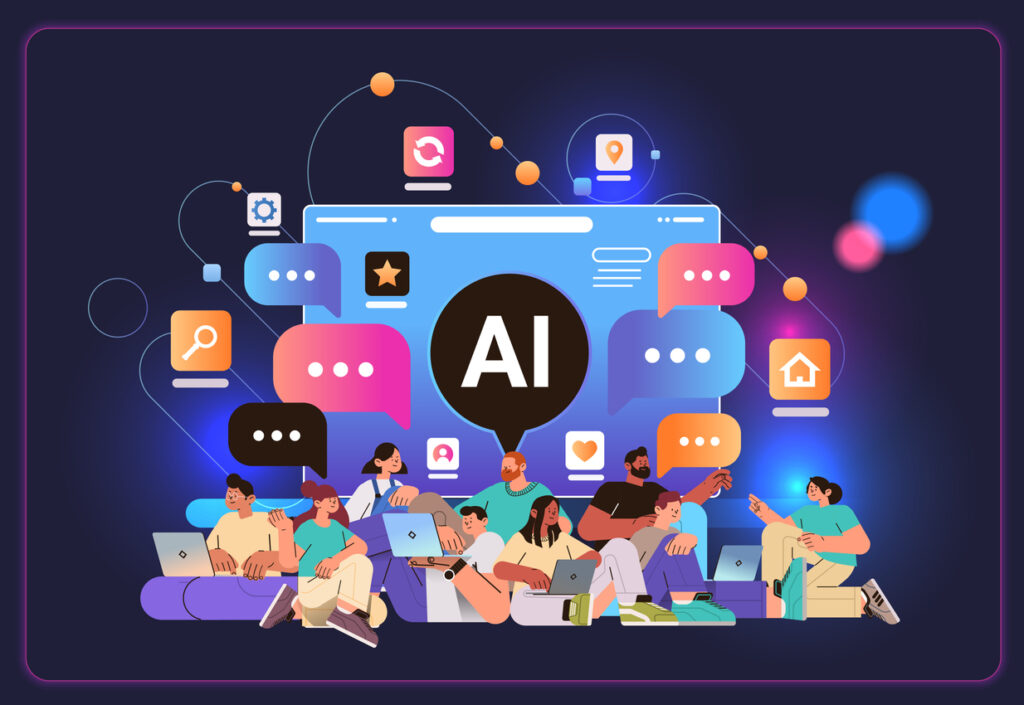This blog post was written by NCTE member Chad Hemmelgarn.
Artificial intelligence (AI)’s prevalence is causing a stir in education. At a recent technology conference, my copresenter and I asked the audience of educators about using AI professionally and for student use. While they favored AI making their jobs easier (aggregating information, helping streamline their work, assisting in “menial” tasks, etc.), they were far less supportive of AI benefiting students in the same ways. This double standard is puzzling—why the difference in attitudes?
I start our classroom AI conversation by reminding my students not to take lightly the six million years of evolution that created them; their insight, perspective, experiences, style, and voice matter.
Some teachers treat AI’s classroom integration like a lice infestation. Districts have students write on paper under supervision to “battle” AI. I am puzzled by the disdain and distrust toward AI. We should explore what AI can do for education instead of fearing what it could do to education. Past innovations like television and computers faced similar unwarranted paranoia before being embraced. Why not skip the distrust phase and explore AI’s educational potential?
I model transparent AI use to students by adding “Created in collaboration with AI” on assignments. For example, AI helped me create a student preference survey combining content standards and a teacher evaluation rubric. Student responses were fed into AI to summarize findings and suggest rigorous lesson ideas aligned with standards and higher-order thinking skills. In seconds, AI provided insights that would typically take me months based on experience alone.
My students and I created a blanket AI usage form to submit with any writing/creating we do not tackle step-by-step in the classroom. We discussed AI’s implications on our work and decided that a student who uses AI to generate more than 15% of their piece is egregiously deceitful and not representing their own thoughts. We have studied popular area universities’ policies concerning AI and academic honesty, exploring the real-world ramifications for AI abuse.
My approach to AI in the classroom has less to do with “kids cheating” or their “laziness,” and everything to do with helping them become informed users rather than secretive abusers. Why do we hate it when it can help students with prewriting or clarify mathematical equations, but love it when it recommends shows to stream or tells us the weather for the next few days? Do we feel uncomfortable as teachers because it questions our approach or pedagogy? In what way does AI threaten us, and how can we harness it to grow our students and ourselves to prepare them to be agile, technologically open-minded adults?
AI does not mean we have to start from scratch. Reconsidering our existing assignments to include AI options is not only good practice for us as educators, it also shows students that their teachers can adapt, and we sincerely have their interests at heart. Using AI in assignments also reminds them we know AI exists, and we want to help them navigate how it can serve as a great tool for them. Crafting AI prompts demonstrates literacy skills that will serve them long after they have forgotten me.
It helps students who do not feel artistic be artistic, those who do not feel creative be creative, and gives those who have difficulty in beginning a task a starting point.
Here follow some examples from my class:
- Rather than analyzing historic speeches, students studied a historical figure’s speeches, identified rhetorical strategies, and used AI to create a new modern speech from that figure addressing current issues. This allowed students to provide input, explore AI’s output for inaccuracies, and understand its limitations.
- Students used AI to create Shakespearean sonnets about anything they chose, we analyzed the accuracy, and then they created their own sonnets together mastering the characteristics of Shakespearean sonnet form using the confidence AI enhanced for them.
- Students have used AI to develop research questions for a passion project, create sections within their research, and even run the completed essay through AI for editing recommendations. Students used AI to summarize articles in a fact-checking exercise, seeing its benefits and shortcomings.
- Students used AI to create stories to review vocabulary terms, used standards to create review questions for story comprehension, and even edited AI writing with standards-based rubrics they created with AI.
- Students used AI to create graphic novel versions of a text for better understanding or even to demonstrate understanding.
- Students used AI generative imaging to create vintage-style travel posters to demonstrate key points from a documentary about their city, which we shared with our chamber of commerce, who will in turn distribute posters to area businesses.
For the naysayers, I am certain I have students who abuse it. I am not so naïve to believe every student finds joy and purpose in every activity they do for my class. (However, they know they can use any activity or assignment they complete as a resource for any assessment we do, so quality has improved).
I am a realist; AI has been here, is here, and will be here. AI will affect every part of our children’s futures. If we nudge and guide them as early adopters, they will reap benefits.
Using AI has freed time and mental energy to invigorate my students and myself.
Consider what AI can do in your classroom: I recommend getting acclimated with it by reading You Look Like a Thing and I Love You by Janelle Shane, as well as this excellent article by Ethan Mollick. Magic School AI is exciting to experiment with, too. Learn with your students. Be vulnerable and take risks. I promise, the excitement of learning something new together will be contagious.
We are at a trailhead with AI and how it will affect education. As educators, we can lead the way by giving our purpose, our students, the preparation they deserve to continue exploring for themselves to see where they can go, and how they can grow with it.
 Chad Hemmelgarn is a driven, constantly evolving 20-year professional educator who thrives on relationship building and connection with students and colleagues in Bexley, a suburb of Columbus, Ohio. He’s also a grade 9 advisor who spearheaded a character-education unit, a high school staff technology advisor who problem solves in action, a PBIS committee member, a former SAT site supervisor, and an English Resource Center director who designed data-based personalized intervention activities across all high school grade levels. Chad is also an educational podcast guest concerning experiential education, a national AP conference presenter, and a textbook author for McGraw Hill Education.
Chad Hemmelgarn is a driven, constantly evolving 20-year professional educator who thrives on relationship building and connection with students and colleagues in Bexley, a suburb of Columbus, Ohio. He’s also a grade 9 advisor who spearheaded a character-education unit, a high school staff technology advisor who problem solves in action, a PBIS committee member, a former SAT site supervisor, and an English Resource Center director who designed data-based personalized intervention activities across all high school grade levels. Chad is also an educational podcast guest concerning experiential education, a national AP conference presenter, and a textbook author for McGraw Hill Education.
It is the policy of NCTE in all publications, including the Literacy & NCTE blog, to provide a forum for the open discussion of ideas concerning the content and the teaching of English and the language arts. Publicity accorded to any particular point of view does not imply endorsement by the Executive Committee, the Board of Directors, the staff, or the membership at large, except in announcements of policy, where such endorsement is clearly specified.

